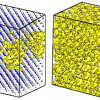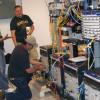News Archive
RISC daddy conjures Moore's Lawless parallel universe
The oft-cited Moore's Law is the fulcrum of the IT industry in that it has provided the means of giving us ever-faster and more sophisticated computing technology over the decades. This in turn allowed the IT industry to convince us that every one, two, or three years, we need new operating systems, better performance, and new and more complex applications. But ask yourself this: What happens to the IT industry if the performance improvements stop? Read More »
Berkeley Lab Team Wins Special ACM Gordon Bell Prize for Algorithm Innovation
AUSTIN, Texas — A team of scientists from the U.S. Department of Energy’s Lawrence Berkeley National Laboratory (Berkeley Lab) has won a prestigious Gordon Bell Prize, sponsored by the Association for Computing Machinery (ACM), for special achievement in high performance computing for their research into the energy harnessing potential of nanostructures. Their method, which was used to predict the efficiency of a new solar cell material, achieved impressive performance and scalability. Read More »
Networking Leaders Announce Initiative to Develop 100 GbE Services
AUSTIN, Texas — Internet2, ESnet, Infinera, Juniper Networks and Level 3 Communications today at the annual SC08 conference announced they have agreed to work together to aggressively develop and test emerging 100 Gigabit Ethernet (GbE) technologies. The initiative will build on fresh-from-the-laboratory technologies to create a 100 GbE testbed on the Internet2 and ESnet networks with an operational network capability soon thereafter. Read More »
ESnet Completes Construction of Dynamic Science Data Network for Researchers
The Department of Energy’s (DOE) Energy Science Network (ESnet) has just completed hardware installations for the nation’s first dynamic circuit network dedicated solely to scientific research, called the Science Data Network (SDN). Read More »
CRD Method for Understanding Nanostructures Is a Gordon Bell Finalist
The key to energy independence from petroleum, coal and other fossil fuels, could be tiny materials called nanostructures. At approximately 100,000 times finer than human hair, these structures may be microscopic individually, but in groups of thousands, they could revolutionize solar cell design by providing a cost-efficient resource for harvesting solar-energy. Read More »
LBNL Researchers Contribute to All Aspects of SC08 Conference
Researchers from Lawrence Berkeley National Laboratory are making significant contributions to the SC08 Conference Technical Program, contributing four technical papers and one research poster, organizing two workshops, participating in two panel discussions, and hosting or co-hosting six birds-of-a-feather sessions (BoFs). SC08, the international conference on high performance computing, networking, storage and analysis, will be held Nov. 15–21 in Austin, Texas. Additionally, UC Berkeley… Read More »
IMG/M Spearheads Analysis into Human Microbial Communities
Within the body of a healthy adult, microbial cells are estimated to outnumber human cells by a factor of ten to one. These tiny organisms cover every surface and cavity of the human body, forming complex communities that help digest food, break down toxins and fight off diseases. Now scientists will be able to gain valuable insights into how these microbial communities affect human health – with a grant from the National Institute of Health (NIH) and the Integrated Microbial Genomics with… Read More »
Science Studio: Juan Meza Discusses Computational Mathematics in KTEP Radio Interview
Juan Meza, head of Berkeley Lab's High Performance Computing Research Department, was interviewed on the radio program “Science Studio” on El Paso NPR station KTEP on November 2, 2008. In the interview, Meza talks about how the field of computational mathematics helps solve problems encountered with silicon wafers, protein folding, and countless more. He also talks about the stigma of the “geek” factor in mathematics. Read More »
Princeton Has New High-Speed Connection to ESnet’s Dynamic ESnet4 Network
The U.S. Department of Energy’s Energy Sciences Network (ESnet) just improved its Internet connections to several institutions on Princeton University’s Forrestal Campus, including the Princeton Plasma Physics Laboratory (PPPL), the High Energy Physics (HEP) Group within the Physics Department at Princeton University, and the National Oceanic and Atmospheric Administration’s Geophysical Fluid Dynamics Laboratory (GFDL). Read More »
Video Explains How ESnet Supports Large Hadron Collider
The Large Hadron Collider (LHC), a new particle accelerator at CERN in Switzerland, provides a massive facility for physicists around the world to investigate the origins of the universe. The world’s largest scientific research project is expected to produce roughly 15 petabytes (15 million gigabytes) of data annually for analysis. Read More »







 Instagram
Instagram YouTube
YouTube



